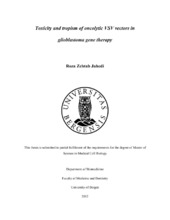Toxicity and tropism of oncolytic VSV vectors in glioblastoma gene therapy
Master thesis
Permanent lenke
https://hdl.handle.net/1956/8156Utgivelsesdato
2012-11-05Metadata
Vis full innførselSamlinger
Sammendrag
Glioblastoma multiforme is the most common and most fatal primary brain tumor in adults. Despite using advanced conventional therapeutic approaches like surgical resection, radiotherapy and chemotherapy only marginal improvement with a median survival of about 14 months is observed. Thus, finding urgent novel therapeutic strategies to target and kill GBM cells are desperately needed. In this respect, gene therapy provides new perspectives for treating cancer, although the safety and efficient delivery of genes into target cells still need critical evaluation in further experiments. In particular, oncolytic viruses are of interest due to their ability to infect and replicate in tumor cells. In this thesis, we analyzed the toxicity and efficiency of Vesicular stomatitis virus (VSV)-based oncolytic virotherapy for the treatment of GBM. Vesicular stomatitis virus (VSV) has the potential to significantly improve the prognosis of aggressive malignancies such as brain cancer but its intrinsic neurotoxicity limited clinical development so far. The cytopathogenicity of vesicular stomatitis virus (VSV) has been attributed mainly to the glycoprotein of VSV (VSV-G). By exchanging the VSV-G with a glycoprotein from a different virus, the tropism of the virus could be changed. Thus, the glycoprotein from the Lymphocytic choriomeningitis virus (LCMV-GP) was used for pseudotyping VSV as this virus is not neurotoxic. By analyzing mouse brains infected with either VSV wild-type or VSV pseudotyped with LCMV-GP, it was obvious that VSV-WT induced a strong inflammatory response mainly consisting of CD3 positive lymphocytes and CD11b positive microglia cells. In contrast, VSV-GP infected brains showed no significant increase in inflammation compared to PBS injected control mice. Further, our results from immunostaining with Caspase-3 and TUNEL assays demonstrated significantly more apoptotic brain cells in the VSV-WT compared to the VSV-GP group. By using confocal microscopy analysis we verified that VSV-WT infected mainly neurons, while VSV-GP did not show infection of brain cells at all. Intravenous injection of VSV-GP virus into mice that harbored, intracerebral U87 gliomas lead to specific infection of the glioma cells, while normal brain cells were spared. 9 | P a g e In conclusion, replication-competent VSV-GP vectors are promising vehicles for future gene therapy of brain cancer as they specifically and efficiently infect brain tumor cells and do not induce a neurotoxic damage to the normal brain tissue.
